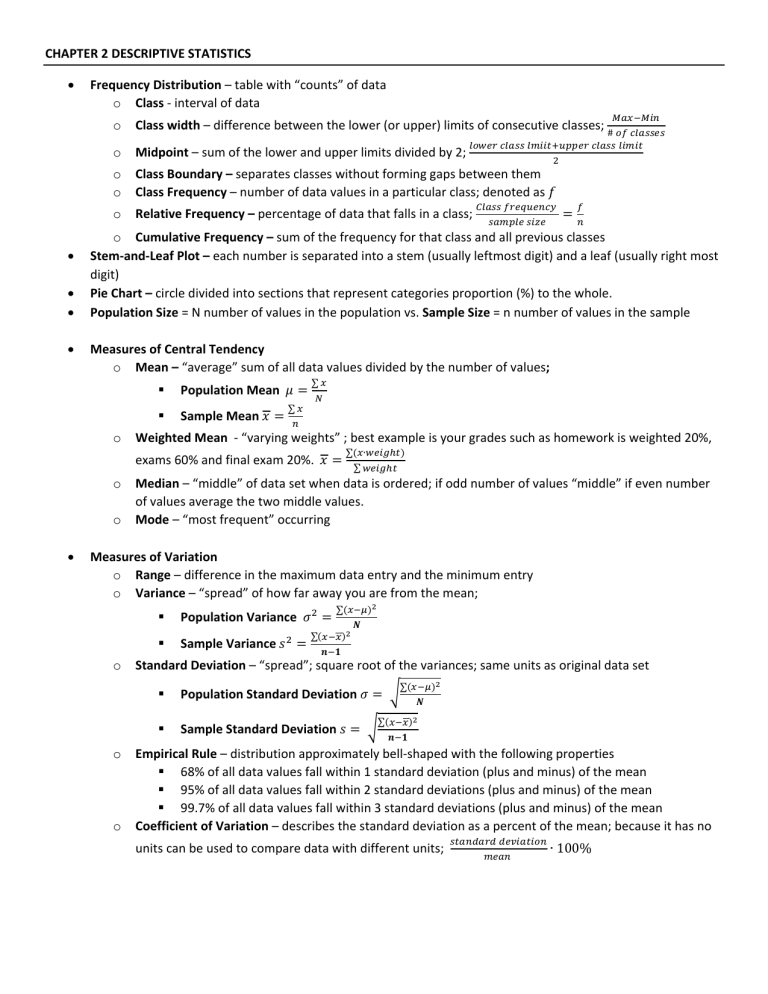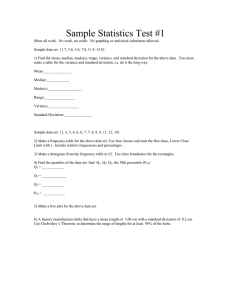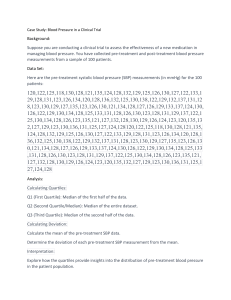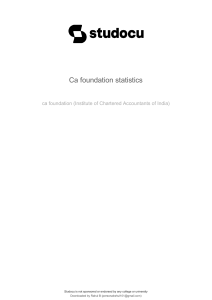
CHAPTER 2 DESCRIPTIVE STATISTICS • Frequency Distribution – table with “counts” of data o Class - interval of data o Class width – difference between the lower (or upper) limits of consecutive classes; o Midpoint – sum of the lower and upper limits divided by 2; o Relative Frequency – percentage of data that falls in a class; o o • • • • 2 Class Boundary – separates classes without forming gaps between them Class Frequency – number of data values in a particular class; denoted as 𝑓𝑓 𝐶𝐶𝐶𝐶𝐶𝐶𝐶𝐶𝐶𝐶 𝑓𝑓𝑓𝑓𝑓𝑓𝑓𝑓𝑓𝑓𝑓𝑓𝑓𝑓𝑓𝑓𝑓𝑓 𝑠𝑠𝑠𝑠𝑠𝑠𝑠𝑠𝑠𝑠𝑠𝑠 𝑠𝑠𝑠𝑠𝑠𝑠𝑠𝑠 = 𝑓𝑓 𝑛𝑛 o Cumulative Frequency – sum of the frequency for that class and all previous classes Stem-and-Leaf Plot – each number is separated into a stem (usually leftmost digit) and a leaf (usually right most digit) Pie Chart – circle divided into sections that represent categories proportion (%) to the whole. Population Size = N number of values in the population vs. Sample Size = n number of values in the sample Measures of Central Tendency o Mean – “average” sum of all data values divided by the number of values; o o o • 𝑀𝑀𝑀𝑀𝑀𝑀−𝑀𝑀𝑀𝑀𝑀𝑀 # 𝑜𝑜𝑜𝑜 𝑐𝑐𝑐𝑐𝑐𝑐𝑐𝑐𝑐𝑐𝑐𝑐𝑐𝑐 𝑙𝑙𝑙𝑙𝑙𝑙𝑙𝑙𝑙𝑙 𝑐𝑐𝑐𝑐𝑐𝑐𝑐𝑐𝑐𝑐 𝑙𝑙𝑙𝑙𝑙𝑙𝑙𝑙𝑙𝑙+𝑢𝑢𝑢𝑢𝑢𝑢𝑢𝑢𝑢𝑢 𝑐𝑐𝑐𝑐𝑐𝑐𝑐𝑐𝑐𝑐 𝑙𝑙𝑙𝑙𝑙𝑙𝑙𝑙𝑙𝑙 Population Mean 𝜇𝜇 = Sample Mean 𝑥𝑥 = ∑ 𝑥𝑥 𝑛𝑛 ∑ 𝑥𝑥 𝑁𝑁 Weighted Mean - “varying weights” ; best example is your grades such as homework is weighted 20%, exams 60% and final exam 20%. 𝑥𝑥 = ∑(𝑥𝑥∙𝑤𝑤𝑤𝑤𝑤𝑤𝑤𝑤ℎ𝑡𝑡) ∑ 𝑤𝑤𝑤𝑤𝑤𝑤𝑤𝑤ℎ𝑡𝑡 Median – “middle” of data set when data is ordered; if odd number of values “middle” if even number of values average the two middle values. Mode – “most frequent” occurring Measures of Variation o Range – difference in the maximum data entry and the minimum entry o Variance – “spread” of how far away you are from the mean; o o 2 Sample Variance 𝑠𝑠 = ∑(𝑥𝑥−𝜇𝜇)2 ∑(𝑥𝑥−𝑥𝑥)2 𝒏𝒏−𝟏𝟏 𝑵𝑵 Standard Deviation – “spread”; square root of the variances; same units as original data set o Population Variance 𝜎𝜎 2 = Population Standard Deviation 𝜎𝜎 = � Sample Standard Deviation 𝑠𝑠 = � ∑(𝑥𝑥−𝜇𝜇)2 𝑵𝑵 ∑(𝑥𝑥−𝑥𝑥)2 𝒏𝒏−𝟏𝟏 Empirical Rule – distribution approximately bell-shaped with the following properties 68% of all data values fall within 1 standard deviation (plus and minus) of the mean 95% of all data values fall within 2 standard deviations (plus and minus) of the mean 99.7% of all data values fall within 3 standard deviations (plus and minus) of the mean Coefficient of Variation – describes the standard deviation as a percent of the mean; because it has no units can be used to compare data with different units; 𝑠𝑠𝑠𝑠𝑠𝑠𝑠𝑠𝑠𝑠𝑠𝑠𝑠𝑠𝑠𝑠 𝑑𝑑𝑑𝑑𝑑𝑑𝑑𝑑𝑑𝑑𝑑𝑑𝑑𝑑𝑑𝑑𝑑𝑑 𝑚𝑚𝑚𝑚𝑚𝑚𝑚𝑚 ∙ 100% • Measures of Position o Quartiles – divide ordered data in equal parts; Q1 25%; Q2 50% (median); Q3 75%; Q4 100% o Interquartile range (IQR) - difference between the third and first quartiles; Q3 – Q1 o Five Number Summary - used for constructing a boxplot Minimum Value Q1 Q2 (median) Q3 Maximum Value





